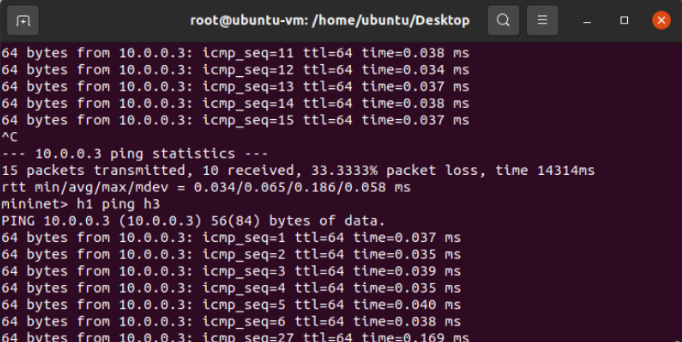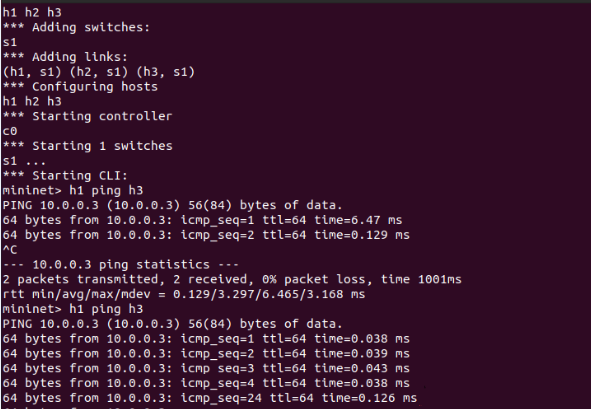第七次SDN实验
1 利用Mininet平台搭建下图所示网络拓扑,并连接OpenDaylight

2 编写Python程序,调用OpenDaylight的北向接口下发指令删除s1上的流表数据
#!/usr/bin/python
import requests
from requests.auth import HTTPBasicAuth
def http_detele(url):
url = url
headers = {'Content-Type': 'application/json'}
resp = requests.delete(url, headers=headers, auth=HTTPBasicAuth('admin', 'admin'))
return resp
if name='main':
url = 'http://127.0.0.1:8181/restconf/config/opendaylight-inventory:nodes/node/openflow:1/'
with open('test.json') as f:
jstr = f.read()
resp = http_detele(url)
print(resp.content)
3 编写Python程序,调用OpenDaylight的北向接口下发硬超时流表,实现拓扑内主机h1和h3网络中断20s
from requests.auth import HTTPBasicAuth
def http_put(url,jstr):
url= url
headers = {'Content-Type':'application/json'}
resp = requests.put(url,jstr,headers=headers,auth=HTTPBasicAuth('admin', 'admin'))
return resp
url='http://127.0.0.1:8181/restconf/config/opendaylight-inventory:nodes/node/openflow:1/flow-node-inventory:table/0/flow/1'
with open('206.json') as f:
jstr = f.read()
resp = http_put(url,jstr)
print (resp.content)
import json
from requests.auth import HTTPBasicAuth
def http_get(url):
url= url
headers = {'Content-Type':'application/json'}
resp = requests.get(url,headers=headers,auth=HTTPBasicAuth('admin','admin'))
return resp
url = 'http://127.0.0.1:8181/restconf/operational/opendaylight-inventory:nodes/node/openflow:1/flow-node-inventory:table/0/opendaylight-flow-table-statistics:flow-table-statistics'
with open('206.json') as f:
jstr = f.read()
resp = http_get(url)
print(resp.content)


2 利用Mininet平台搭建下图所示网络拓扑,要求支持OpenFlow 1.3协议,主机名、交换机名以及端口对应正确。拓扑生成后需连接Ryu,且Ryu应能够提供REST API服务

import requests
from requests.auth import HTTPBasicAuth
def http_post(url,jstr):
url= url
headers = {'Content-Type':'application/json'}
resp = requests.post(url,jstr,headers=headers)
return resp
url='http://127.0.0.1:8080/stats/flowentry/add'
with open('206-Ryu-1.json') as f:
jstr = f.read()
resp = http_post(url,jstr)
print (resp.content)
"dpid": 1,
"match": {
"in_port": 1
},
"actions": [
{
"type": "PUSH_VLAN",
"ethertype": 33024
},
{
"type": "SET_FIELD",
"field": "vlan_vid",
"value": 4096
},
{
"type":"OUTPUT",
"port": 3
}
],
"priority":5
}' http://localhost:8080/stats/flowentry/add
curl -X POST -d '
{
"dpid": 1,
"priority":5,
"match": {
"in_port": 2
},
"actions": [
{
"type": "PUSH_VLAN",
"ethertype": 33024
},
{
"type": "SET_FIELD",
"field": "vlan_vid",
"value": 4097
},
{
"type":"OUTPUT",
"port": 3
}
]
}' http://localhost:8080/stats/flowentry/add
curl -X POST -d '
{
"dpid": 1,
"match": {
"vlan_vid": 0
},
"actions": [
{
"type": "POP_VLAN",
"ethertype": 33024
},
{
"type":"OUTPUT",
"port": 1
}
],
"priority":5
}
' http://localhost:8080/stats/flowentry/add
curl -X POST -d'
{
"dpid": 1,
"match": {
"vlan_vid": 1
},
"actions": [
{
"type": "POP_VLAN",
"ethertype": 33024
},
{
"type":"OUTPUT",
"port": 2
}
],
"priority":5
}
' http://localhost:8080/stats/flowentry/add
curl -X POST -d '
{
"dpid": 2,
"match": {
"in_port": 1
},
"actions": [
{
"type": "PUSH_VLAN",
"ethertype": 33024
},
{
"type": "SET_FIELD",
"field": "vlan_vid",
"value": 4096
},
{
"type":"OUTPUT",
"port": 3
}
],
"priority":5
}' http://localhost:8080/stats/flowentry/add
curl -X POST -d '
{
"dpid": 2,
"match": {
"in_port": 1
},
"actions": [
{
"type": "PUSH_VLAN",
"ethertype": 33024
},
{
"type": "SET_FIELD",
"field": "vlan_vid",
"value": 4096
},
{
"type":"OUTPUT",
"port": 3
}
],
"priority":5
}' http://localhost:8080/stats/flowentry/add
curl -X POST -d '
{
"dpid": 2,
"match": {
"in_port": 1
},
"actions": [
{
"type": "PUSH_VLAN",
"ethertype": 33024
},
{
"type": "SET_FIELD",
"field": "vlan_vid",
"value": 4096
},
{
"type":"OUTPUT",
"port": 3
}
],
"priority":5
}' http://localhost:8080/stats/flowentry/add
curl -X POST -d '
{
"dpid": 2,
"match": {
"in_port": 1
},
"actions": [
{
"type": "PUSH_VLAN",
"ethertype": 33024
},
{
"type": "SET_FIELD",
"field": "vlan_vid",
"value": 4096
},
{
"type":"OUTPUT",
"port": 3
}
],
"priority":5
}' http://localhost:8080/stats/flowentry/add
心得体会:本次实验对我来说具有一定难度,实验期间遇到的第一个问题是运行上一次实验创建的 L2Switch.py 出现错误,报错“AttributeError: module 'ryu.ofproto.ofproto_v1_0' has no attribute 'OFPET_EXPERIMENTER'”,始终未找到最终原因。最后改用安装 Ryu 时自带的simple_switch_13.py,成功启动。
这次一下这么大的代码量修改了许多次。但也用到了之前的许多知识如RYU的平台,让我认识到了如这些工具的重要性,也让我更加熟悉了平台的使用。



 浙公网安备 33010602011771号
浙公网安备 33010602011771号